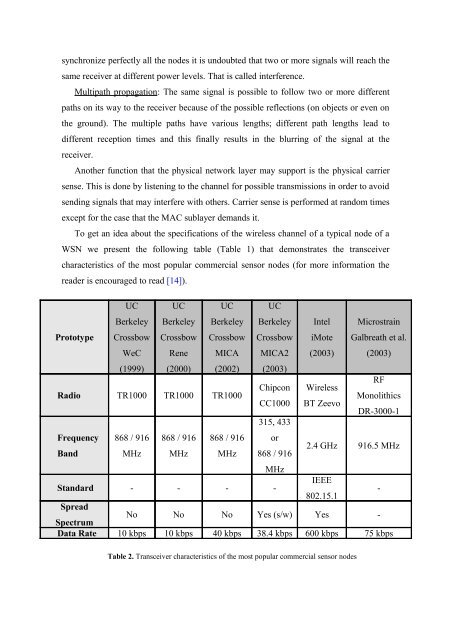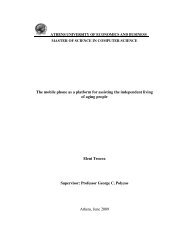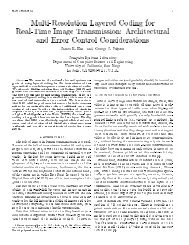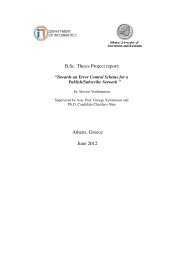In Network Processing and Data Aggregation in
In Network Processing and Data Aggregation in
In Network Processing and Data Aggregation in
You also want an ePaper? Increase the reach of your titles
YUMPU automatically turns print PDFs into web optimized ePapers that Google loves.
synchronize perfectly all the nodes it is undoubted that two or more signals will reach thesame receiver at different power levels. That is called <strong>in</strong>terference.Multipath propagation: The same signal is possible to follow two or more differentpaths on its way to the receiver because of the possible reflections (on objects or even onthe ground). The multiple paths have various lengths; different path lengths lead todifferent reception times <strong>and</strong> this f<strong>in</strong>ally results <strong>in</strong> the blurr<strong>in</strong>g of the signal at thereceiver.Another function that the physical network layer may support is the physical carriersense. This is done by listen<strong>in</strong>g to the channel for possible transmissions <strong>in</strong> order to avoidsend<strong>in</strong>g signals that may <strong>in</strong>terfere with others. Carrier sense is performed at r<strong>and</strong>om timesexcept for the case that the MAC sublayer dem<strong>and</strong>s it.To get an idea about the specifications of the wireless channel of a typical node of aWSN we present the follow<strong>in</strong>g table (Table 1) that demonstrates the transceivercharacteristics of the most popular commercial sensor nodes (for more <strong>in</strong>formation thereader is encouraged to read [14]).PrototypeUCBerkeleyCrossbowWeCUCBerkeleyCrossbowReneUCBerkeleyCrossbowMICAUCBerkeleyCrossbowMICA2<strong>In</strong>teliMote(2003)Microstra<strong>in</strong>Galbreath et al.(2003)(1999) (2000) (2002) (2003)Radio TR1000 TR1000 TR1000RFChipcon WirelessMonolithicsCC1000 BT ZeevoDR-3000-1315, 433Frequency 868 / 916 868 / 916 868 / 916 orB<strong>and</strong> MHz MHz MHz 868 / 9162.4 GHz 916.5 MHzMHzSt<strong>and</strong>ard - - - -IEEE802.15.1-SpreadSpectrumNo No No Yes (s/w) Yes -<strong>Data</strong> Rate 10 kbps 10 kbps 40 kbps 38.4 kbps 600 kbps 75 kbpsTable 2. Transceiver characteristics of the most popular commercial sensor nodes








